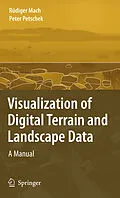This book approaches the realisation of digital terrain and landscape data through clear and practical examples. From data provision and the creation of revealing analyses to realistic depictions for presentation purposes, the reader is led through the world of digital 3-D graphics. The authors' deep knowledge of the scientific fundamentals and many years of experience in 3-D visualization enable them to lead the reader through a complex subject and shed light on previously murky virtual landscapes.
Autorentext
Rüdiger Mach
The author studied hydraulic engineering and has been engaged in CAD construction, 3D animation and image editing in a technical / scientific environment for over 15 years. He writes books about 3D visualization, and works as an engineer and lecturer in the field of technical and scientific visualization. As a senior project manager of the ViewTec Ltd., he is responsible for 3D visualization, the scientific depiction of results and everything to do with design and communication of visual problem solving.
Peter Petschek
After his studies in Germany and the USA from 1987 1996, the author progressed to occupational activity as a landscape architect in several offices (EDSA Fort Lauderdale, Knoll Sindelfingen, Kienast Zürich) with the emphasis placed on IT implementation in free area design. In 1991 he was called as professor for technology in landscape architecture, department of landscape architecture, to HSR Hochschule für Technik Rapperswil, Switzerland.
Zusammenfassung
This book reflects a profound change that has taken place in the practice of landscape architecture and planning in the past twenty years. Traditional modes of representation pen, pencil, watercolor, marker, et al have been supplanted by digital modeling and animation. This transformation is not just in the medium of representation, however; it is more than a subs- tution of one marking device for another, such as may have been the case in the past when, for example, mechanical pens with cartridges replaced pens with nibs that were filled by dipping. Even changes such as that had their impacts (as longer straighter lines, for example, or more precision in details became possible) on the interplay between designer, design - dium, and designed artifact(s). The emergence of digital media as rep- sentational tools for designers has accompanied a transformation in the language of discourse in design and planning, in the very conception of the designed world we live in, and in the substance and role of the essential representations and abstractions used by planners and designers. In the past, when 2D planar representations (drawings, usually on paper) served as the conventional means of communication for designers (both with themselves and with others), physical objects or arrangements in 3D were transformed into a series of lines in 2D (plans, sections, elevations, e. g.
Inhalt
Fundamentals and Data Source.- 3D Visualization of Terrain Data.- Using the Camera.- Lighting.- Vegetation.- Atmosphere.- Water.- Rendering & Post Processing.- Interaction with 3D Data.- Practical Examples.
